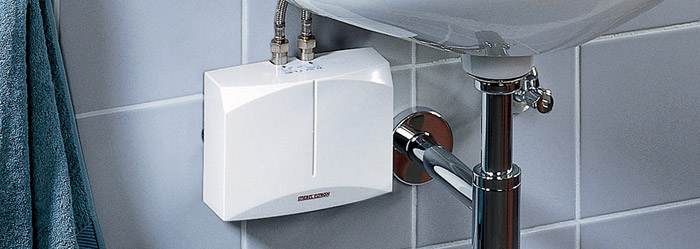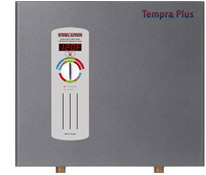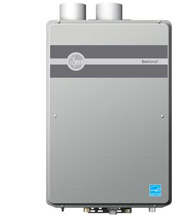Tankless Water Heater
A WATER HEATER THAT’S RIGHT FOR YOU
There comes a time when we say goodbye to our old water heater.
With foresight we can replace it with a new model, that saves energy and money, and sometimes even space.

The water heating industry in North America has changed greatly. Where we used to be faced only with the decision of what size tank to buy, we now consider energy efficiency and technology. That’s where tankless, often called “on-demand,” water heaters come in.
A huge technological achievement, these innovative systems show significant energy savings over tank-type water heaters (which also means they save you money). Their much-smaller size saves valuable living space as well.
There are two major categories of tankless water heaters: whole house and point-of-use.

A whole house unit would be installed in a central location and completely replaces a standard tank water heater.

A point-of-use unit provides hot water for a single fixture. Typically, this would be a sink located far from a central hot water source. Because of its very small size, a point-of-use unit is usually located right under the sink.
AT-A GLANCE BENEFITS:
Enjoy huge savings on your energy bills – in some cases you could save up to 50%!
Endless supply of instant hot water.
No storage tank saves valuable space.
Lifespan up to twice as long as conventional tank water heaters.
HOW THEY WORK
Tankless water heater provides an endless supply of hot water for as long as it’s needed. Because these systems provide hot water on demand, they don’t require a storage tank to store hot water. No storage or holding tank means that tankless water heaters have a life span twice as long as traditional systems because the risk of rust and corrosion is significantly lower.
Gas-Powered Tankless Water Heaters
Gas-powered systems are fuelled by propane or natural gas and heat the water with a burner. A tankless gas water heater needs a gas line to the water heater, and the unit must be vented to the outside.
 If tankless gas is replacing a gas tank-type water heater, typically it requires a larger gas line. Venting may also need to be upgraded.
If tankless gas is replacing a gas tank-type water heater, typically it requires a larger gas line. Venting may also need to be upgraded.
The right size unit can provide endless hot water for up to two major applications at a time. This unit is a great replacement for a tank water heater.
Electric Tankless Water Heaters
Tankless electric water heaters heat the water with an electrical element and are a great replacement for a tank model. A tankless electric water heater needs to be hardwired to the circuit breaker/electrical panel.
 Tankless electric water heaters do not need to be vented. Although tankless electric water heaters may output fewer GPM than a tankless gas unit, the larger electric units can provide endless hot water for up to two major applications.
Tankless electric water heaters do not need to be vented. Although tankless electric water heaters may output fewer GPM than a tankless gas unit, the larger electric units can provide endless hot water for up to two major applications.
They are less expensive to purchase than gas tankless, and their smaller size and lack of venting may allow them to be installed where gas tankless units cannot go.
DID YOU KNOW?
Gallons Per Minute (GPM) represents the amount of hot water a tankless water heater provides per minute. Warm incoming water allows a unit to output a higher GPM than cold incoming water. Determining the total GPM of all fixtures that would run at the same time is helpful when sizing a tankless water heater for your home.
Proudly serving the community with expert plumbing and gas services since 2007.
